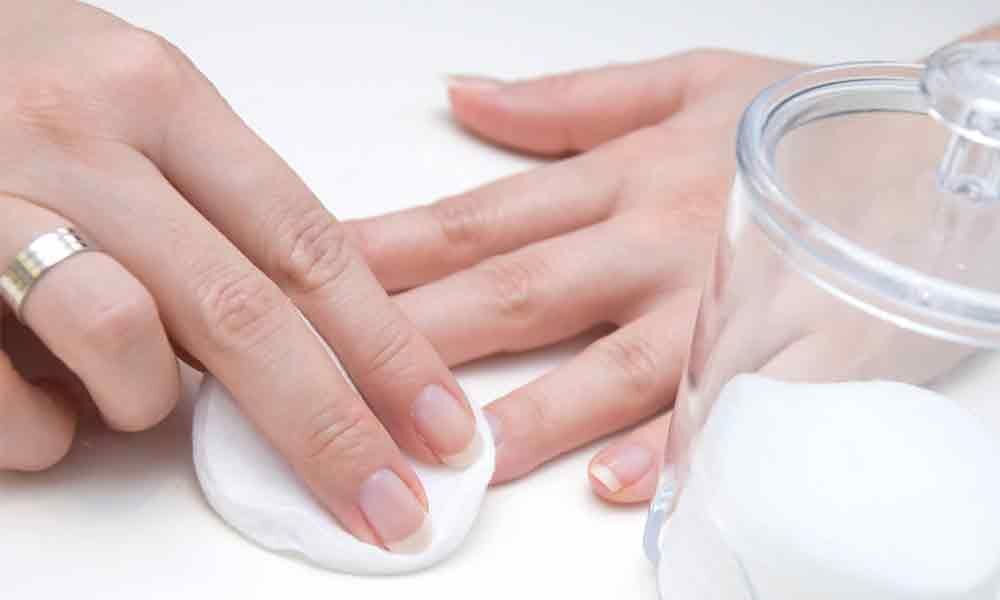Tips to Remove Polish from Your Nails, Skin, and Clothing

The beautiful manicure or pedicure that you had a couple of days or weeks ago is beginning to look drab.
The beautiful manicure or pedicure that you had a couple of days or weeks ago is beginning to look drab. Or on your skin or a favorite shirt, you may have accidentally smeared polish. Acetone and non-acetone nail polish removers are the gold standard for polish removal and are considered safe to use in small quantities. However, you can also try some household products. Keep in mind that many of these methods of DIY home removal are not supported by research, but if you're in a pinch, they may be worth trying. Continue reading to learn about all your options and precautions for safety. Nail polish remover
For skin Nail polish remover
non-acetone nail polish remover
Nail polish remover
rubbing alcohol
alcohol spirits (such as vodka, grappa, gin)
hand sanitizer
toothpaste
hydrogen peroxide and hot water soak
nail file (for filing and chipping)
stain-fighting detergent (followed by lamination).
You may find that applying a clear coat of new nail polish and wiping it off quickly helps to soften and remove the old polish. Although this is anecdotal, you may find that this does the trick if you're out of the OTC nail polish remover.
Alcohol rubbing is a solvent, which means it helps to break down things. Soaking your nails in alcohol rubbing or applying them to nails with a soaked ball of cotton can dissolve the polish.
This method may take longer than using traditional nail polish remover, but it may simply do the job without running out of the store. Alcohol spirits If you want to remove your nail polish, your liquor cabinet might be the place to go. Spirits such as vodka, grappa or gin have a high content of alcohol and can soften your polish if you soak your nails in it. Try to wipe or peel off the polish after submerging your nails for several minutes.
Hand sanitizer A hand sanitizer bottle is handy? It's another product based on alcohol that you can use on your nails to soften the polish.
Try soaking your hands with it to see if it softens your nail polish, then rub it off with a ball or cloth of cotton. Toothpaste is another staple in the household that you can try to remove. Scrub with a basic toothpaste or one with baking soda, which is a gentle abrasive, on your nails. Use a cloth to wipe your nail after a few minutes of scrubbing and see if this method has worked.
Hydrogen peroxide and hot water soak Hydrogen peroxide is used for lightening purposes in many cosmetics and beauty products and can also help remove your old manicure or pedicure. In a bowl of hydrogen peroxide and hot water, try soaking your nails. This can help soften the polish so that it can be wiped or filed away gently. Filing, peeling or chipping off polish If your nail polish is nearing the end of its life on your nails, you may find it will come off if you use your other fingernails or a nail file to work on it. Be careful not to use this method to damage your nail. Overfilling may take off your nail's top layer, which may be harmful and painful.
OTC Nail polish removers
There is a variety to choose from if you decide to use a traditional nail polish remover. You may wonder what product is the best and safest to use with so many options. OTC nail polish removers contain either acetone or are labeled as "non-acetone." Keep in mind that both products contain chemicals that can be harmful to you if you use them too often or without proper ventilation.
Acetone breaks down nail polish quickly and effectively as to how to use acetone and non-acetone nail polish removers. It is low in toxicity compared with other chemicals that can remove nail polish.
Non-acetone nail polish removers may be less toxic than acetone-based removers, but you may find that removing the polish takes longer and does not remove dark nail polish colors.
Non-acetone products still contain chemicals that with prolonged use can be harmful. The only way to remove gel nail polish is a prolonged soak in acetone.
Consider using acetone-dipped cotton balls on your nails instead of soaking them in a substance container to avoid exposing your skin to the acetone.
Nail polish removal tips Nail polish remover can be tough on your nails and skin, so use as instructed and not too often. In a well-ventilated room, use a cotton ball or presoaked nail polish remover pad.
Use nail polish remover to moisturize with lotion. If possible, only use the nail polish remover on the fingernails and only for a short time. In order to maintain their health, consider taking a break from painting your nails so often.
How to remove nail polish from your skin If at home you give yourself a manicure or pedicure, some nail polish will probably end up on your skin. Try to remove the following: Nail polish remover, either acetone or non-acetone, using a cotton ball or cotton warm water swab one of the above-mentioned alcohol-based solutions: rubbing alcohol, spirits, hand sanitizer Moisturize with lotion after removing the nail polish as these methods can dry your skin.
HEALTHLINE PARTNER SOLUTIONS Get answers in minutes from a doctor, do you have any medical questions?
Connect online or by phone with a board-certified, experienced doctor. Pediatrists and other experts are available 24/7. How to remove nail polish from your clothes If you accidentally wound on your clothes with nail polish, here are a few removal tips.
Try to keep the stain as fast as possible and ensure that it does not spread. Then, to remove as much polish as possible, use an absorbent paper product such as a paper towel or a piece of toilet paper.
Finally, dab a cotton swab or a small piece of a rag into either acetone or non-acetone nail polish remover and loosen the stain. Here are some other ways to get nail polish out of your clothes: using a stain-fighting detergent that adds white vinegar to your washing cycle to lift the stain that washes your clothes immediately after staining to ensure that the stain does not set a dry cleaner to remove a deep nail polish stain.
Acetone quickly evaporates, so be careful not to overuse the product. Long-term acetone exposure can lead to headaches and dizziness. Acetone is very flame retardant as well, so avoid using it around an open flame. Keep away from children acetone and non-acetone nail polish removers and never ingest them. This may give rise to lethargy and confusion. If taken by mouth, removers of non-acetone nail polish may be more harmful than removers of acetone nail polish.
One study highlighted two cases of non-acetone nail polish remover ingested by children. Both children had adverse symptoms such as heart failure, vomiting, hypotension, and a slowing heart rate. Is it bad for me to remove acetone (and other solvents) in OTC nail polish remover? It should not be harmful to use a small amount of acetone or non-acetone nail polish remover. Be careful not to ingest or leave the bottle where it can be ingested by a child. The chemicals in the remover of the nail polish can damage your nails by breaking them. Should I switch to natural methods permanently? You can try to remove nail polish using natural methods, but you may find that the most effective and least time-consuming OTC removers.
Try a few times a month to restrict your exposure to OTC removers to just a few minutes. On the Environmental Working Group website, you can review the safety of nail polish removers.
What happens if I'm pregnant?
When you are pregnant, you can still paint your nails and remove polish. You're going to want to limit your chemical exposure, so try to reduce the number of times you get manicure or pedicure throughout your pregnancy. Make sure that in a well-ventilated room you paint and remove nail polish. Try not to use gel polish as there is not much research available on whether, during pregnancy, this type of nail treatment is safe.
Takeaway
There are several ways of safely and effectively removing nail polish. Over-the-counter removal products may work best, but you can experiment with household products such as alcohol rubbing and hand sanitizer if you're in a pinch. Make sure that after removing polish, you moisturize your skin and nails to avoid dryness.
















